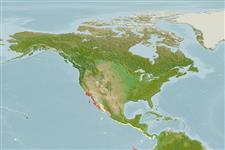Teleostei (teleosts) >
Cyprinodontiformes (Rivulines, killifishes and live bearers) >
Fundulidae (Topminnows and killifishes)
Etymology: Fundulus: Latin, fundus = bottom; a peculiar name for a topminnow, coined for a bottom species of Atlantic coast being "the abode of the fundulus mudfish" (Ref. 45335).
More on author: Girard.
Environment: milieu / climate zone / depth range / distribution range
Ecology
Marine; freshwater; brackish; benthopelagic; non-migratory. Subtropical
Eastern Pacific: Morro Bay, California, USA to Bahía Magdalena, Baja California, Mexico.
Size / Weight / Age
Maturity: Lm ? range ? - ? cm
Max length : 10.8 cm TL male/unsexed; (Ref. 6792); common length : 7.0 cm TL male/unsexed; (Ref. 12193); max. reported age: 3.00 years (Ref. 12193)
Commonly found in bays and salt marshes near shore, may enter freshwater (Ref. 36572). Often used in laboratories for environmental studies. Not a seasonal killifish. Is very difficult to maintain in aquarium (Ref. 27139). Oviparous, with micro-nektonic larvae (Ref. 36572). Single demersal eggs are attached to spawning substrate via small weakly adhesive filaments (Ref. 36572).
Life cycle and mating behavior
Maturities | Reproduction | Spawnings | Egg(s) | Fecundities | Larvae
Huber, J.H., 1996. Killi-Data 1996. Updated checklist of taxonomic names, collecting localities and bibliographic references of oviparous Cyprinodont fishes (Atherinomorpha, Pisces). Société Française d'Ichtyologie, Muséum National d'Histoire Naturelle, Paris, France, 399 p. (Ref. 27139)
IUCN Red List Status (Ref. 130435)
Threat to humans
Harmless
Human uses
Fisheries: commercial; aquarium: commercial
Tools
Special reports
Download XML
Internet sources
Estimates based on models
Preferred temperature (Ref.
123201): 14.9 - 28.3, mean 22.5 °C (based on 121 cells).
Phylogenetic diversity index (Ref.
82804): PD
50 = 0.5000 [Uniqueness, from 0.5 = low to 2.0 = high].
Bayesian length-weight: a=0.00891 (0.00441 - 0.01802), b=3.23 (3.06 - 3.40), in cm total length, based on LWR estimates for this species & Genus-body shape (Ref.
93245).
Trophic level (Ref.
69278): 3.3 ±0.2 se; based on size and trophs of closest relatives
Generation time: 1.2 ( na - na) years. Estimated as median ln(3)/K based on 1
growth studies.
Resilience (Ref.
120179): High, minimum population doubling time less than 15 months (K=0.93; tmax=3).
Fishing Vulnerability (Ref.
59153): Low vulnerability (15 of 100).
